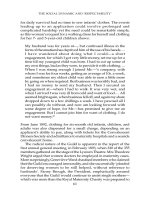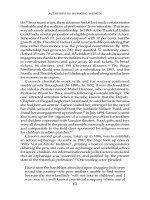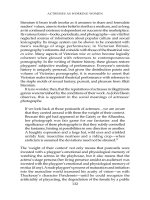ACTRESSES AS WORKING WOMEN 158
Bạn đang xem bản rút gọn của tài liệu. Xem và tải ngay bản đầy đủ của tài liệu tại đây (25.58 KB, 1 trang )
ACTRESSES AND THE MISE EN SCÈNE
or partially undraped’. A National Vigilance campaigner described
the ‘mere nudities’ of the tableau based on Johann Dannecker’s
sculpture Ariadne:
‘Ariadne’…so far as I can put it into language, represents a naked
woman lying on the back of a lion. There were 4 or 5 wrinkles
on the lower parts of the limb, distinguishing it from an ordinary
picture. The left leg was placed under the lower part of the right
leg, producing these wrinkles. She was lying in such a position
that had it not been for the tights gross indecency would have
been the result.
The model for Henrietta Ray’s Naiad barely enhanced the decency of
her tights by wearing a thin wisp of gauze over her loins:
The next picture to which I took exception was a picture called
the ‘Naiad,’ & this picture represents a woman lying on a mound,
slightly on the left side. The face is upturned, the neck, stomach,
thighs & legs are fully exposed. Of course…. I believe there were
tights. A very thin piece of gauze, mark you, is thrown slantingly
across the person, but not sufficient to hide.
Although the gauze was ‘such as would pass not only through a finger
ring, but through a lace hole’ the LCC Theatres and Music Halls
Committee ruled that the provision of a thin scarf or spray of flowers
across the pelvis was a sufficient compromise to decency. As long as
the Palace realized works of fine art, it was up to the spectators to
remind themselves of the presence of tights even though seeing them
was ‘a matter of inference & faith, not of observation & knowledge’.67
Objections were just as unsuccessful in 1881, when an individual
complained to the Lord Chamberlain that Drury Lane’s ‘Statue Ballet’
featured ‘about 30 girls in tights from head to feet without a vestige of
skirt & only a thin scarf for an apology to shield them’. Officials
consulted various parties, including a clergyman, and concluded the
plaintiff must be ‘one of the overnice people who bring to the theatre
the prurience which they see there’.68 A similar device of costumed
nudity was used in the Crystal Palace’s pantomime of 1887–8. ‘An
English Mother’ complained: ‘A band of girls, about 30, I should
think, from the ages of 10 to 16, naked to their waists, perform a
dance [hand] in hand with just a little fringe of net perfectly
transparent & which flies open as they dance.’ She continued,
129









